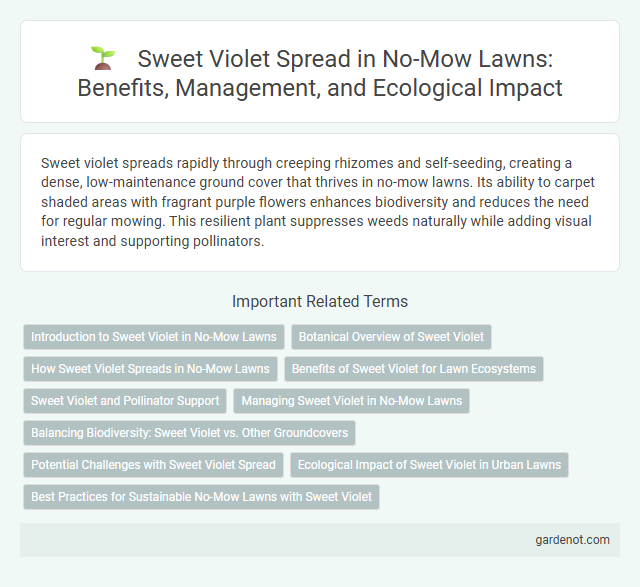Sweet violet spreads rapidly through creeping rhizomes and self-seeding, creating a dense, low-maintenance ground cover that thrives in no-mow lawns. Its ability to carpet shaded areas with fragrant purple flowers enhances biodiversity and reduces the need for regular mowing. This resilient plant suppresses weeds naturally while adding visual interest and supporting pollinators.
Introduction to Sweet Violet in No-Mow Lawns
Sweet violet (Viola odorata) thrives in no-mow lawns due to its low growth habit and shade tolerance, providing a fragrant, ground-covering carpet. Its ability to spread through creeping rhizomes allows for natural lawn filling, reducing the need for mowing and promoting biodiversity. Sweet violet also supports pollinators, making it an eco-friendly choice for sustainable, low-maintenance turf alternatives.
Botanical Overview of Sweet Violet
Sweet violet (Viola odorata) is a low-growing, perennial flowering plant known for its fragrant purple blossoms and heart-shaped leaves. This shade-tolerant species spreads primarily through creeping rhizomes and self-seeding, forming dense mats that suppress grass growth, making it ideal for no-mow lawns. Its ability to thrive in moist, well-drained soils and adaptability to partial shade conditions contributes to its success as a groundcover in sustainable landscaping.
How Sweet Violet Spreads in No-Mow Lawns
Sweet violet spreads primarily through rhizomes and seed dispersal, establishing dense patches in no-mow lawns where regular mowing doesn't disrupt growth. Its creeping underground stems allow it to colonize surrounding soil, creating a natural ground cover that thrives in shaded and partially sunny areas. Seed dispersal by wind, animals, and self-propelled seed pods further enhances its spread, making Sweet violet a common and resilient component of low-maintenance no-mow lawn ecosystems.
Benefits of Sweet Violet for Lawn Ecosystems
Sweet violet (Viola odorata) spreads through creeping rhizomes and self-seeding, establishing dense ground cover that suppresses weeds and reduces soil erosion in no-mow lawn ecosystems. Its fragrant flowers attract pollinators like bees and butterflies, enhancing biodiversity and supporting local food webs. The plant's natural resilience and low maintenance help maintain soil moisture and contribute to healthier, more sustainable lawns without regular mowing.
Sweet Violet and Pollinator Support
Sweet violet (Viola odorata) naturally spreads to form dense, low-growing mats in no-mow lawns, enhancing ground cover with minimal maintenance. Its fragrant flowers bloom early in spring, providing vital nectar and pollen resources for emerging pollinators such as bees and butterflies. Incorporating sweet violet supports biodiversity by attracting and sustaining beneficial insect populations within sustainable lawn ecosystems.
Managing Sweet Violet in No-Mow Lawns
Sweet violet (Viola odorata) can rapidly spread in no-mow lawns due to its creeping rhizomes and seed dispersal, creating dense patches that may outcompete grass. Managing sweet violet involves maintaining optimal soil conditions and employing targeted manual removal to prevent its dominance while preserving the low-maintenance aesthetic. Regular monitoring helps detect early infestations, allowing for timely interventions without disrupting the ecological balance of the no-mow landscape.
Balancing Biodiversity: Sweet Violet vs. Other Groundcovers
Sweet violet (Viola odorata) promotes biodiversity by attracting pollinators and providing habitat for beneficial insects, which supports ecosystem health in no-mow lawns. Compared to traditional groundcovers like clover or creeping thyme, sweet violet offers dense foliage that suppresses weeds while enhancing soil quality through organic matter. Integrating sweet violet balances aesthetic appeal with ecological function, fostering a resilient and low-maintenance lawn environment.
Potential Challenges with Sweet Violet Spread
Sweet violet (Viola odorata) spreads aggressively through rhizomes, making it difficult to contain within a designated no-mow lawn area. Its dense growth can outcompete desirable grasses, leading to uneven turf and reduced biodiversity. Managing sweet violet spread often requires regular monitoring and targeted removal to prevent it from dominating the lawn ecosystem.
Ecological Impact of Sweet Violet in Urban Lawns
Sweet violet (Viola odorata) spreads rapidly through rhizomes and seed dispersal, creating dense ground cover in no-mow urban lawns that supports local pollinators, including bees and butterflies. Its presence enhances biodiversity by providing habitat and nectar within fragmented urban ecosystems, contributing to ecological balance. The plant's low maintenance and natural weed suppression reduce the need for chemical herbicides, promoting healthier soil and minimizing environmental pollution.
Best Practices for Sustainable No-Mow Lawns with Sweet Violet
Sweet violet (Viola odorata) naturally thrives in shaded no-mow lawns, providing dense ground cover that reduces soil erosion and inhibits weed growth. Maintaining a consistent moisture level and avoiding heavy foot traffic encourages healthy spread, promoting biodiversity and minimizing lawn maintenance. Incorporating sweet violet enhances sustainable landscapes by supporting pollinators and reducing the need for synthetic fertilizers and pesticides.
Sweet violet spread Infographic

 gardenot.com
gardenot.com